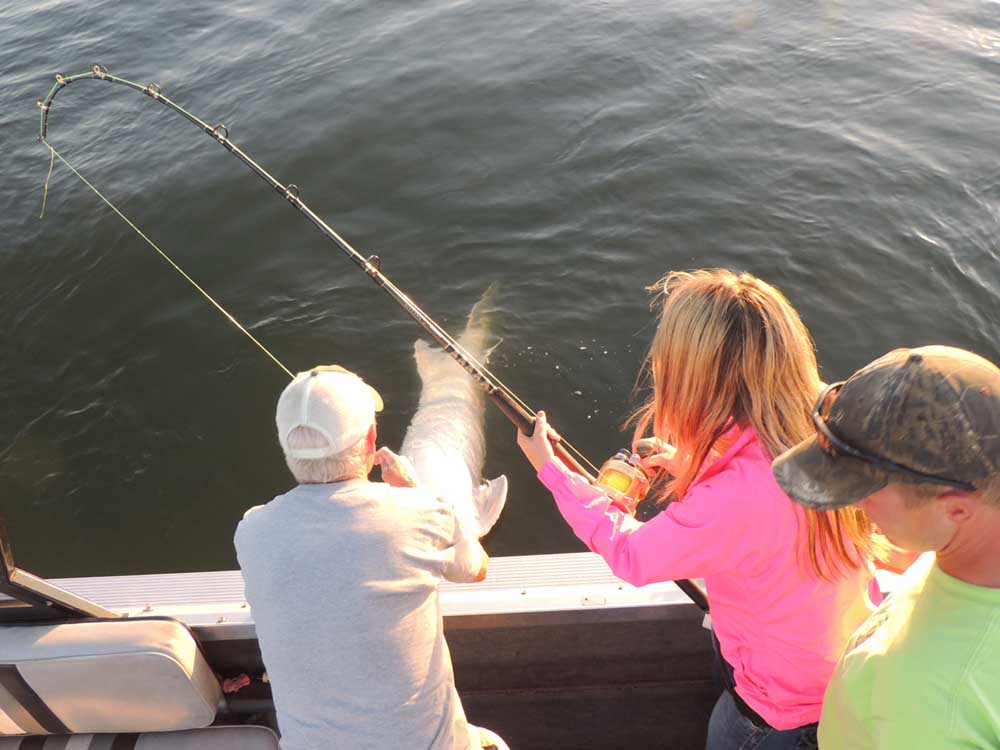Sturgeon fishing on the Columbia River
Published 12:00 am Wednesday, July 30, 2014

- Sturgeon fishing on the Columbia River
After an hour, the 80-pound line started to powder. That’s what happens when the stress is so great, the line is almost at its breaking point. Little puffs of green popped from the mono, and curly strands frayed like split ends on an aging rock star.
Erin Dauenhauer, who makes her living as a hairstylist, recommended a keratin treatment. I suggested Lee try to get a bit of line back and bury the damage on the spool.
On one end of the line was a 400-pound sturgeon. On the other, a 180-pound firefighter, my friend Lee Sandberg. Minutes into the battle, the great beast ripped line around a rocky spire about 35 feet down. We saw it in the chatter of the rod.
At the helm, Greg Gustafson went into action and spun the boat back in the opposite direction to unwrap the fish from the rocks.
As soon as Sandberg felt the fish solid again, he put the backbone of the big Melton rod to its test. It would be an hour before we saw the beast of the fish that had taken a whole shad as the bait.
Now we followed the fish wherever it wanted to go, and it mostly wanted to go downstream. We took turns, fighting the fish to an angry standstill alongside the boat.
Still we had not accomplished our goal. Erin had fought and lost one. She had looked a 10-foot sturgeon in the eyeball when it leaped next to the boat, but we wanted one she could call hers. We even cut the bait down in hopes we’d hook a smaller one.
It had been what Gustafson called a slow day, a couple of hours of waiting, of rebaiting, of positioning in the current before the first fish, close to 10 feet long, took the bait and began to streak away, throwing the hook at the top of a leap.
Gustafson prepared the baits that we found beneath the impatient beaks of seagulls. Shad are the main food source of the sturgeon.Millions of the giant minnows streak upriver in May, June and July to cast their spawn on the water. The biomass creates a sturgeon feeding frenzy as the big fish follow them upstream.
Erin caught a shad in the dip net, and minutes later it had a couple of half-hitches around it and a hook at the beak.
After Sandberg’s sturgeon was released, we tied to the buoy again and slipped the baits into the current. Shadows began to lengthen, and Mount Hood took on an orange glow.
The 23-year-old from Ashland stood on the gunnel and hung from the skeleton of the roof canopy. She dipped her toes in the water and watched the rod tip. Down in the mighty river, a beast followed a scent trail that bled out of an unfortunate shad.
Sometimes the smallest fish makes the rod tip shake a lot more than a big one will. A big sturgeon with a mouth like a garbage can will just park on the bait, and that might translate to a trembling in the rod.
We saw that tremor, and the 23-year-old tiptoed to the rod holder where she eased the rod out and then punched the big old fish with the hook set. Instead of jumping like the first two had done, this one blasted away. Sandberg strapped the fighting belt around her waist while I reeled in the other rod and Gustafson threw off the bow line. We’d follow the dinosaur down the river.
Before he’d caught his, Sandberg said his previous biggest fish had been a tuna, maybe 15 pounds. Now this was fish No. 4, and the two from Southern Oregon had figured out how to fight them.
To battle the big ones, it takes the whole body. Wedge the toes in the gunwale, seat the rod butt below the belt, put a thumb on the spool, grasp the rod at the top of the handle, lean back, gain a little line, reel down and do it again. It worked muscles that the hairdresser didn’t know she had. She’d gain 10 feet of line as the fish would turn its head and pull out 30 feet.
It’s hard to say how long that fish was, but at the boat, 40 minutes later, it looked most of 9 feet, its gray and white body already swollen with shad.
As more of the food fish make it up to The Dalles and beyond through July and into August, the beasts will gather beneath the dams to feed on their carcasses. The wind turbines beat on the horizon, and the great river’s energy flows in harness through the dam. There is no better place to test one’s own power than against the great dinosaur of the Columbia.
— Gary Lewis is the host of “Frontier Unlimited” and author of “John Nosler — Going Ballistic,” “A Bear Hunter’s Guide to the Universe,” “Hunting Oregon” and other titles. Contact Lewis at www.GaryLewisOutdoors.com.






